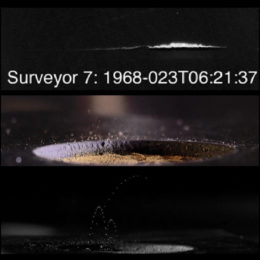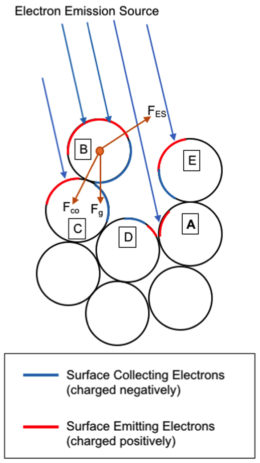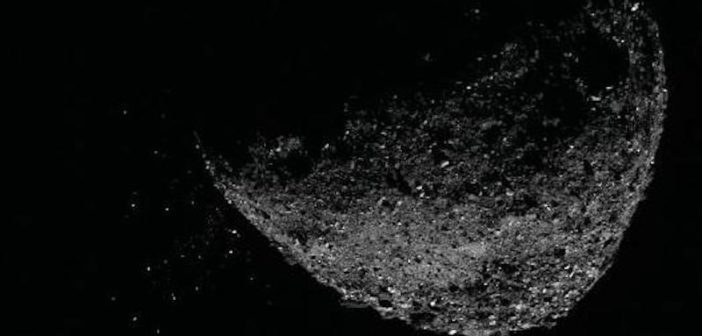
Top: A Moon lander observed a glow on the lunar horizon, possibly caused by suspended particles. Middle and bottom: Lab experiments show that electrostatic lofting can lift particles several centimeters. [NASA/CU-Boulder/LASP]
Ejection Events
When the Origins, Spectral Interpretation, Resource Identification, Security-Regolith Explorer (OSIRIS-REx) spacecraft arrived at nearby asteroid Bennu in 2018 after a two-year journey, it observed rocky particles up to 10 centimeters in size being ejected from the asteroid’s surface.
Closer to home, laboratory experiments have found that the repulsion between particles with similar electrical charges can cause them to levitate. Could the same process be responsible for the particles seen escaping from Bennu?

Diagram depicting the simplified model surface particles (circles) and the forces at play. The red areas emit electrons, which are collected by blue areas. Under certain conditions, the electrostatic force (FES) between areas with like charge can overcome the forces of gravity (Fg) and cohesion (FCO) and allow the particle to escape. [Adapted from Hartzell et al. 2022]
Charging Up an Asteroid’s Surface
In a new publication, a team led by Christine Hartzell (University of Maryland) investigated whether this process of electrostatic lofting could cause the particle ejection events seen by OSIRIS-REx. In order for particles to be lifted in this way, they must build up enough electrical charge — from impinging solar photons as well as electrons and ions of the solar wind — to overcome the combined forces of gravity and cohesion, which work to keep the particles stuck to the asteroid’s surface.
Using a simplified model composed of particles of identical shape and size, the team found that electrostatic lofting can raise small particles off Bennu’s sunlit surface. The size of the lofted particles was strongly dependent on how cohesive the surface material is; if the cohesion is low, particles a few tenths of a millimeter in size could escape, while only micron-size particles could depart if the cohesion is high.
From Day to Night
The team also considered whether electrostatic lofting could explain the particles seen lifting off from Bennu’s night side. On the night side, the particles are not exposed to sunlight, so they mainly become charged when electrons from the solar wind curl around from the opposite side of the asteroid and strike the surface, knocking electrons free.

Top: Electric field needed to lift particles on Bennu’s dayside for low (S=0.1; black) and high (S=0.75; blue) cohesion, compared to the expected electric field (red). Bottom: Required and present electric field strengths on the night side for low cohesion values and different densities of the solar wind. Click to enlarge. [Adapted from Hartzell et al. 2022]
Ultimately, the team concluded that electrostatic particle lofting is unlikely to be responsible for ejecting the large particles seen by OSIRIS-REx, but it may selectively remove small particles from Bennu’s surface. However, the case isn’t fully closed: further work may show that the asteroid’s irregular shape causes strong electric fields to develop in certain areas, which could be the sites of larger particle ejections. What’s more, the planned return of a sample of Bennu’s surface in 2023 should also give scientists more information about the surface material and allow for more accurate modeling of electrostatic lofting — stay tuned!
Bonus
Curious about the fate of particles ejected from Bennu’s surface? Check out the video below to follow the trajectories of particles ejected in the four largest events observed by OSIRIS-REx. [M. Brozovic/NASA/JPL-Caltech/University of Arizona]
Citation
“An Evaluation of Electrostatic Lofting and Subsequent Particle Motion on Bennu,” Christine Hartzell et al 2022 Planet. Sci. J. 3 85. doi:10.3847/PSJ/ac5629
